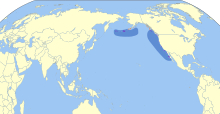
The tufted puffin, also known as crested puffin, is a relatively abundant medium-sized pelagic seabird in the auk family (Alcidae) found throughout the North Pacific Ocean. It is one of three species of puffin that make up the genus Fratercula and is easily recognizable by its thick red bill and yellow tufts.

Puffins are any of three species of small alcids (auks) in the bird genus Fratercula. These are pelagic seabirds that feed primarily by diving in the water. They breed in large colonies on coastal cliffs or offshore islands, nesting in crevices among rocks or in burrows in the soil. Two species, the tufted puffin and horned puffin, are found in the North Pacific Ocean, while the Atlantic puffin is found in the North Atlantic Ocean.

An auk or alcid is a bird of the family Alcidae in the order Charadriiformes. The alcid family includes the murres, guillemots, auklets, puffins, and murrelets. The family contains 25 extant or recently extinct species that are divided into 11 genera.

Seabirds are birds that are adapted to life within the marine environment. While seabirds vary greatly in lifestyle, behaviour and physiology, they often exhibit striking convergent evolution, as the same environmental problems and feeding niches have resulted in similar adaptations. The first seabirds evolved in the Cretaceous period, and modern seabird families emerged in the Paleogene.

The pigeon guillemot is a species of bird in the auk family, Alcidae. One of three species in the genus Cepphus, it is most closely related to the spectacled guillemot. There are five subspecies of the pigeon guillemot; all subspecies, when in breeding plumage, are dark brown with a black iridescent sheen and a distinctive wing patch broken by a brown-black wedge. Its non-breeding plumage has mottled grey and black upperparts and white underparts. The long bill is black, as are the claws. The legs, feet, and inside of the mouth are red. It closely resembles the black guillemot, which is slightly smaller and lacks the dark wing wedge present in the pigeon guillemot.

The common murre also called the common guillemot or foolish guillemot,(Uria aalge) is a large auk. It has a circumpolar distribution, occurring in low-Arctic and boreal waters in the North Atlantic and North Pacific. It spends most of its time at sea, only coming to land to breed on rocky cliff shores or islands.
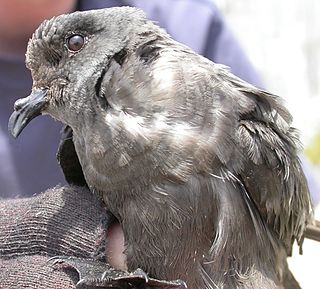
The ashy storm petrel is a small, scarce seabird of the storm petrel family Hydrobatidae. It breeds colonially on islands off the coasts of California and Mexico, and is one of six species of storm petrel that live and feed in the rich California Current system.

The western gull is a large white-headed gull that lives on the west coast of North America and the Pacific Ocean. The western gull ranges from British Columbia, Canada, to Baja California, Mexico.

The parakeet auklet is a small seabird of the North Pacific. Parakeet Auklets used to be placed on its own in the genus Cyclorrhynchus but recent morphological and genetic evidence suggest it should be placed in the genus Aethia, making them closely related to crested auklets and least auklets. It is associated with the boreal waters of Alaska, Kamchatka and Siberia. It breeds on the cliffs, slopes and boulder fields of offshore islands, generally moving south during the winter.

The rhinoceros auklet is a seabird and a close relative of the puffins. It is the only extant species of the genus Cerorhinca. Given its close relationship with the puffins, the common name rhinoceros puffin has been proposed for the species.
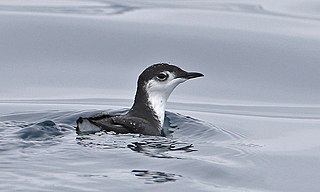
The Guadalupe murrelet or Xantus's murrelet is a small seabird found in the California Current system in the Pacific Ocean. This auk breeds on islands off California and Mexico. It is threatened by predators introduced to its breeding colonies and by oil spills.

Kittlitz's murrelet is a small alcid found in the waters off Alaska and Eastern Siberia. This near threatened species is, like the closely related marbled murrelet, unusual for seabirds in not being colonial, nesting instead in isolated locations on mountain tops, where the nests were known to Native Americans for many years before skeptical ornithologists described and photographed them. It is a poorly known and little studied species, although concern over its status and that of the closely related marbled murrelet has led to a recent increase in research.

The whiskered auklet is a small seabird of the auk family. It has a more restricted range than other members of its genus, Aethia, living only around the Aleutian Islands and on some islands off Siberia, and breeding on these islands. It is one of the smallest alcids, only the closely related least auklet being smaller. Its name is derived from the long white feathers on its face that are part of its breeding plumage.

The least auklet is a seabird and the smallest species of auk. It is the most abundant seabird in North America, and one of the most abundant in the world, with a population of around nine million birds. They breed on the islands of Alaska and Siberia, and spend the winter close to the edge of the ice sheet. Their largest colonies are on the Aleutian Islands, St. Lawrence Island and Little Diomede Island.
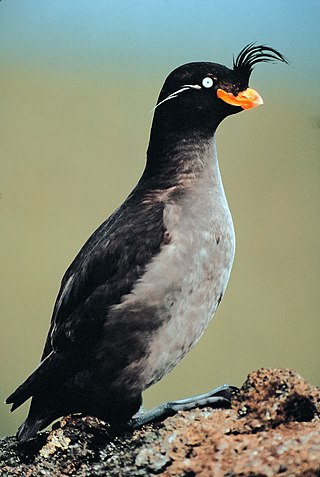
The crested auklet is a small seabird of the family Alcidae, distributed throughout the northern Pacific and the Bering Sea. The species feeds by diving in deep waters, eating krill and a variety of small marine animals. It nests in dense colonies of up to 1 million individuals in the Bering Sea and the Sea of Okhotsk. It often breeds in mixed-species colonies with the least auklet, a smaller congener.

The fork-tailed storm petrel is a small seabird of the storm petrel family Hydrobatidae. It is the second-most abundant and widespread storm petrel and is the only bird in its family that is bluish-grey in colour.

Craveri's murrelet is a small seabird which breeds on offshore islands in both the Pacific Ocean and the Gulf of California off the Baja peninsula of Mexico. It also wanders fairly regularly as far as central California in the US, primarily during post-breeding dispersal. It is threatened by predators introduced to its breeding colonies, by oil spills, and by tanker traffic. Increasing tourism development and commercial fishing fleets also further threaten the species. With an estimated population of 6,000-10,000 breeding pairs, its population is listed as vulnerable.
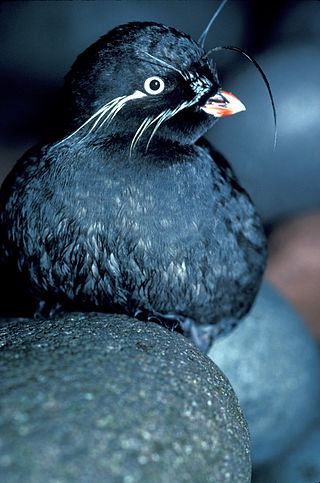
Aethia is a genus of four small (85–300g) auklets endemic to the North Pacific Ocean, Bering Sea and Sea of Okhotsk and among some of North America's most abundant seabirds. The relationships between the four true auklets remains unclear. Auklets are threatened by invasive species such as Norway rats because of their high degree of coloniality and crevice-nesting.

Scripps's murrelet is a small seabird found in the California Current system in the Pacific Ocean. This auk breeds on islands off California and Mexico. It is threatened by predators introduced to its breeding colonies and by oil spills.
Dow's puffin is an extinct seabird in the auk family described in 2000 from subfossil remains found in the Channel Islands of California. It was approximately as large as the modern horned puffin and its beak appeared to have been an intermediate between the rhinoceros auklet and the horned puffin. It lived during the Late Pleistocene and Early Pleistocene on the Channel Islands, where it nested alongside the ancient murrelet, Cassin's auklet and Chendytes lawi.

